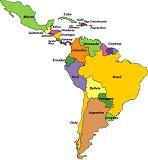Growing
Latin America will expand in 2010
 We maintain that Latin America--LatAm--will expand in 2010 after contracting more than 2% in 2009. Better global growth prospects and solid commodity prices will support growth in the region. However, differentiation in domestic demand dynamics will play a key role.
We maintain that Latin America--LatAm--will expand in 2010 after contracting more than 2% in 2009. Better global growth prospects and solid commodity prices will support growth in the region. However, differentiation in domestic demand dynamics will play a key role.
We have revised upward our growth expectations for Brazil, Mexico, Argentina and Peru; maintained our projection for Colombia; and lowered them for Chile (due to the earthquake) and Venezuela. Mexico will benefit the most from the upward revisions to our U.S. growth outlook, while domestic demand will likely catch up in Q2 2010. Meanwhile, Brazil's stronger-than-expected domestic demand will be enhanced by the relatively benign external backdrop.
Inflation will likely climb in 2010 but it will remain within the central bank inflation target ranges, except for Mexico. In most countries, high food prices, as a result of adverse weather conditions, have continued to deteriorate inflation dynamics and expectations at the beginning of 2010, while demand-pull inflation pressures have stayed relatively calm.
Moving forward we expect those dynamics to revert. Inflation pressures stemming from food prices will likely normalize as seasonal effects wear off, while the closing of the output gaps, though at different speeds, will exert upward pressure on prices. Moreover, the lack of external supply side shocks on prices and stable/strong currencies will play in favor of our inflation outlook for the region.
Current account deficits should widen in 2010--and surpluses will narrow--as growth in domestic demand will likely outpace external demand. Meanwhile, positive global financial conditions and risk appetite, together with LatAm's attractive growth dynamics, will likely continue drawing capital flows, reducing balance of payments issues whenever they arise. Moreover, international reserves will likely continue growing as central banks intervene to avoid sharp appreciation of the currencies and to improve external buffers.
We still believe that wider growth and interest rate differentials, as well as a relatively weak U.S. dollar and solid commodity prices, will continue to support LatAm currencies. Since we expect the Fed will remain on hold for a prolonged period of time, until Q1 2011 or perhaps beyond, and China will only map out excess liquidity slowly, global liquidity conditions will stay elevated and risk appetite--in the absence of systemic events--will remain supportive.
Lastly, the presidential electoral cycle in the main LatAm countries continues with Colombia in May and Brazil in October. In both cases a second voting round will likely be needed to determine the next president. In Colombia it is our view that whoever wins the elections is likely to maintain Colombia's current domestic security and market-oriented policies.
The latest polls by Ipsos Napolen Franco (March 2010) suggest Juan Manuel Santos from the U party and Noemi Sanin from the Conservative party--both strong supporters of President Alvaro Uribe's successful policies--are leading the pack with 36% and 17% of responses, respectively. In Brazil, regardless of who takes power among the leading contenders, the current economic policy will most likely be maintained.
However, the markets will pay close attention to fiscal dynamics and initiatives on structural reform after the elections. The latest Datafohla poll (March 2010) indicates that Jose Serra from the Social Democratic Party leads the race with 36% of responses, followed by Dilma Rousseff from the Workers Party with 27%. Serra also leads the race in a possible second round.
Nouriel Roubini is a professor at the Stern Business School at New York University and chairman of Roubini Global Economics. Bertrand Delgado is a Senior Research Economist at RGE.
(Published by Forbes Magazine - April 29, 2010)